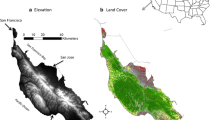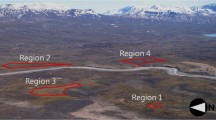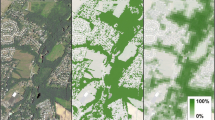Abstract
Landsat imagery is routinely used to characterize stand-level forest communities, but low temporal resolution makes pixel-wise characterization of phenology difficult. This limitation can be overcome by using multi-year imagery, but organizing Landsat scenes by calendar date ignores phenological gradients across the landscape as well as inter-annual differences in both scene- and pixel-wise phenology. We demonstrate how a spatially generalizable, phenologically-informed approach for re-ordering Landsat pixels can be used to characterize spatial variations in autumn senescence in several forest tree species. Using end-of-season estimates derived from MODIS phenology data, we determined the “days left in season” (DLiS) across Landsat images to produce a synthesized phenological trajectory of the normalized difference infrared index (NDII). We used ground-based species composition data in conjunction with the NDII trajectories to model autumn senescence by species. Absolute phenology differed by one and a half to 3 weeks between northern and southern Wisconsin, USA, but we show that the relative timing of phenology for individual species differs across regions by only 1–3 days when considering senescence with respect to the local end of the season. The progression of species senescence was consistent in lowland stands, starting with green and black ash, followed by silver maple, yellow birch, red maple, and tamarack. The image analyses suggest that senescence progressed more rapidly in southern than northern Wisconsin, starting earlier but taking about ten more days in the north. Our results support the use of MODIS phenological data with multi-year Landsat imagery to detect species with unique phenologies and identify how these vary across the landscape.






Similar content being viewed by others
References
Ahl DE, Gower ST, Burrows SN et al (2006) Monitoring spring canopy phenology of a deciduous broadleaf forest using MODIS. Remote Sens Environ 104:88–95
Ahlgren CE (1957) Phenological observations of nineteen native tree species in northeastern Minnesota. Ecology 38:622–628
Canty A, Ripley B (2009) Boot: bootstrap R (S-Plus) Functions. R package version 1.2, 38
Curtis JT (1959) The vegetation of Wisconsin: an ordination of plant communities. The University of Wisconsin Press, Madison
de Beurs KM, Townsend PA (2008) Estimating the effect of gypsy moth defoliation using MODIS. Remote Sens Environ 112:3983–3990
Delbart N, Kergoat L, Toan TL et al (2005) Determination of phenological dates in boreal regions using normalized difference water index. Remote Sens Environ 97:26–38
Delbart N, Picard G, Le Toan T et al (2008) Spring phenology in boreal Eurasia over a nearly century time scale. Global Change Biol 14:603–614
Dixon KR (1976) Analysis of seasonal leaf fall in north temperate deciduous forests. Oikos 27:300–306
Dymond CC, Mladenoff DJ, Radeloff VC (2002) Phenological differences in tasseled cap indices improve deciduous forest classification. Remote Sens Environ 80:460–472
Escudero A, del Arco JM (1987) Ecological significance of the phenology of leaf abscission. Oikos 49:11–14
Fisher JI, Mustard JF (2007) Cross-scalar satellite phenology from ground, Landsat, and MODIS data. Remote Sens Environ 109:261–273
Fisher JI, Mustard JF, Vadeboncoeur MA (2006) Green leaf phenology at Landsat resolution: scaling from the field to the satellite. Remote Sens Environ 100:265–279
Gao BC (1996) NDWI: a normalized difference water index for remote sensing of vegetation liquid water from space. Remote Sens Environ 58:257–266
Haack RA, Jendek E, Liu H et al (2002) The emerald ash borer: a new exotic pest in North America. Mich Ento Soc News 47:1–5
Hardisky MA, Klemas V, Smart RM (1983) The influence of soil salinity, growth form, and leaf moisture on the spectral radiance of Spartina alterniflora canopies. Photogramm Eng Remote Sens 49:77–83
Hilker T, Wulder MA, Coops NC et al (2009) Generation of dense time series synthetic Landsat data through data blending with MODIS using a spatial and temporal adaptive reflectance fusion model. Remote Sens Environ 113:1988–1999
Hwang T, Song C, Vose JM, Band LE (2011) Topography-mediated controls on local vegetation phenology estimated from MODIS vegetation index. Landscape Ecol. doi:10.1007/s10980-011-9580-8
Jolly WM, Nemani R, Running SW (2005) A generalized, bioclimatic index to predict foliar phenology in response to climate. Global Change Biol 11:619–632
Knutson RM (1997) An 18-year study of litterfall and litter decomposition in a northeast Iowa deciduous forest. Amer Midland Naturalist 138:77–83
Kodani E, Awaya Y, Tanaka K, Matsumura N (2002) Seasonal patterns of canopy structure, biochemistry and spectral reflectance in a broad-leaved deciduous Fagus crenata canopy. For Ecol Mgmt 167:233–249
Kokaly RF, Despain DG, Clark RN, Livo KE (2003) Mapping vegetation in Yellowstone national park using spectral feature analysis of AVIRIS data. Remote Sens Environ 84:437–456
Lechowicz MJ (1984) Why do temperate deciduous trees leaf out at different times? Adaptation and ecology of forest communities. Amer Naturalist 124:821–842
Lee DW, O’Keefe J, Holbrook NM, Field TS (2003) Pigment dynamics and autumn leaf senescence in a New England deciduous forest, eastern USA. Ecol Research 18:677–694
Leopold A, Jones SE (1947) A phenological record for Sauk and Dane counties, Wisconsin, 1935–1945. Ecol Monogr 17:81–122
Liang L, Schwartz MD (2009) Landscape phenology: an integrative approach to seasonal vegetation dynamics. Landscape Ecol 24:465–472
Martin ME, Newman SD, Aber JD, Congalton RG (1998) Determining forest species composition using high spectral resolution remote sensing data. Remote Sens Environ 65:249–254
Mickelson JG, Civco DL, Silander JA (1998) Delineating forest canopy species in the Northeastern United States using multi-temporal TM imagery. Photogramm Eng Remote Sens 64:891–904
Morisette JT (2009) MODIS for NACP. Goddard Space flight center, National Aeronautics and Space Administration, USA. Available from http://accweb.nascom.nasa.gov/. (Accessed Jan2010)
Ozdogan M (2010) The spatial distribution of crop types from MODIS data: temporal unmixing using independent component analysis. Remote Sens Environ 114:1190–1204
Resaco J, Hale AN, Henry MC, Gorchov DL (2007) Detecting an invasive shrub in a deciduous forest understory using late-fall Landsat sensor imagery. Int J Remote Sens 28:3739–3745
Richardson AD, Bailey AS, Denny EG et al (2006) Phenology of a northern hardwood forest canopy. Global Change Biol 12:1174–1188
Roy DP, Ju J, Lewis P et al (2008) Multi-temporal MODIS-Landsat data fusion for relative radiometric normalization, gap filling, and prediction of Landsat data. Remote Sens Environ 112:3112–3130
Schwartz MD, Reed BC, White MA (2002) Assessing satellite-derived start-of-season measures in the coterminus USA. Int J Climatol 22:1793–1805
Stimson HC, Breshears DD, Ustin SL, Kefauver SC (2005) Spectral sensing of foliar water conditions in two co-occurring conifer species: Pinus edulis and Juniperus monosperma. Remote Sens Environ 96:108–118
Tateno R, Aikawa T, Takeda H (2005) Leaf-fall phenology along a topography-mediated environmental gradient in a cool-temperate deciduous broad-leaved forest in Japan. J For Res 10:269–274
Townsend PA (2001) Relationships between vegetation patterns and hydroperiod on the Roanoke River Floodplain, North Carolina. Plant Ecol 156:43–58
Townsend PA, Walsh SJ (2001) Remote sensing of forested wetlands: application of multitemporal and multispectral satellite imagery to determine plant community composition and structure in southeastern USA. Plant Ecol 157:129–149
White A, deBeurs KM, Didan K et al (2009) Intercomparison, interpretation, and assessment of spring phenology in North America estimated from remote sensing for 1982–2006. Global Change Biol 15:2335–2359
Williams AP, Hunt ER Jr (2002) Estimation of leafy spurge cover from hyperspectral imagery using mixture tuned matched filtering. Remote Sens Environ 82:446–456
Wolter PT, Mladenoff DJ, Host GE, Crow TR (1995) Improved Forest Classification in the Northern Lake States Using Multi-Temporal Landsat Imagery. Photogramm Eng Remote Sens 61:1129–1143
Young J, Hopkins E, Anderson L (2007) Climate Summaries by Location. Wisconsin State Climatology Office. Department of Atmospheric and Oceanic Sciences, University of Wisconsin—Madison. Available from http://www.aos.wisc.edu/~sco/. (Accessed Jan 2010)
Zhang X, Goldberg MD (2011) Monitoring fall foliage coloration dynamics using time-series satellite data. Remote Sens Environ 115:382–391
Acknowledgments
This research was funded by the Wisconsin Department of Natural Resources. Two anonymous reviewers provided feedback that greatly improved the manuscript. The authors would like to thank Jane Cummings-Carlson for collaborative support, Aditya Singh for discussion and computing support, Clayton Kingdon for help with editing and image processing, Peter Wolter for in-depth discussions, and Suming Jin for processing insights. Thanks also to Kelly Doyle, Jennifer Limbach, and Angelique Edgerton, and Nathan Rehberg for field assistance. Finally, we would like to thank the USGS for opening the Landsat data archive.
Author information
Authors and Affiliations
Corresponding author
Electronic supplementary material
Below is the link to the electronic supplementary material.
Rights and permissions
About this article
Cite this article
Isaacson, B.N., Serbin, S.P. & Townsend, P.A. Detection of relative differences in phenology of forest species using Landsat and MODIS. Landscape Ecol 27, 529–543 (2012). https://doi.org/10.1007/s10980-012-9703-x
Received:
Accepted:
Published:
Issue Date:
DOI: https://doi.org/10.1007/s10980-012-9703-x




